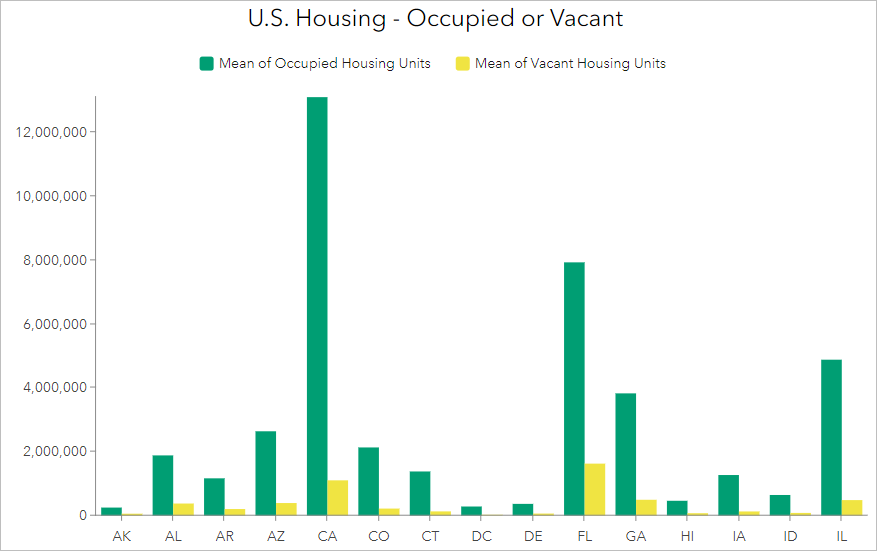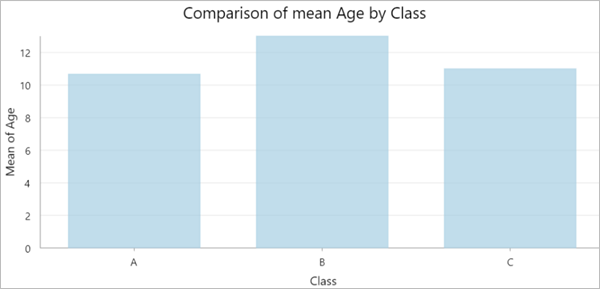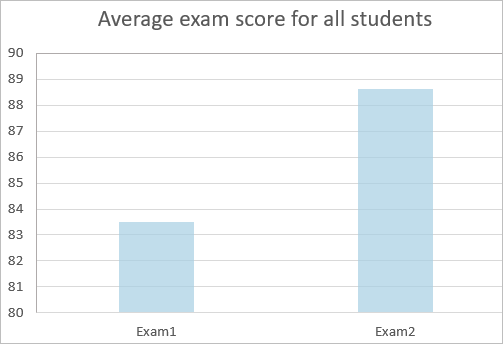The Chart widget displays quantitative attributes from a data source as a graphical representation. It allows users to visualize and observe possible patterns and trends from raw data.
Currently, you can choose from bar, column, line, area, and pie charts, scatter plots, and histograms. Depending on the category type that you choose when configuring the widget, the chart can represent the statistic value of fields for aggregated groups or the statistics of all values for specific fields.
Bar, column, line, and area charts are all series charts, which rely on a series of data to render the display. A data series is a set of data that is displayed on a chart. You can think of a series as an array of values based on the attribute. Each instance in the array is a data point. When plotted on a chart, each data point has a shape. One or more series can be displayed at a time in a series chart. For example, a chart can show the total number of occupied and vacant housing units in each U.S. state. The number of occupied units in each state is a series, and the number of vacant units is another series. Each population of a state is a data point in that series.

Pie charts express part-to-whole relationships in data. Each slice represents one component and all slices added together equal the whole. Each slice is a data point that illustrates numerical proportion to the whole.
Scatter plots use points plotted on a graph to show the relationship between two variables.
Histograms visually summarize the distribution of continuous numeric variables by measuring the frequency at which certain values appear in data sets. The Chart widget's histograms classify data into various bins, which are ranges between intervals, and show the number data points in each bin. Histograms are appropriate for showing distribution.
Examples
Use this widget to support app design requirements such as the following:
- You want to show statistic graphics for a feature layer.
- You want to analyze and visualize data patterns.
- You want to compare feature attributes graphically.
Usage notes
The widget requires a data source. You can use the chart widget on a page with or without a displayed map. After selecting a data source, you select a chart template to start with a specific chart type.
The data source for a chart can be one of the following:
- Operational layers, including a feature layer or scene layer in an existing map or added from a service
- Tables from a map, including a related table
- Output data source of another widget, such as query result of the Query widget
To create a histogram chart or calculate a median for any chart, the connected data source must have percentile-continuous or percentile-discrete supported as a statistics type. Layers that support percentiles include the supportsPercentileStatistics property as true in the advancedQueryCapabilities layer object. Learn more about layer properties.
Settings
The Chart widget includes the following settings:
- Data source—Select source data with attributes to analyze in the Chart widget. In the data view settings, you can filter the data to restrict what appears in the widget, sort the data to display features in a particular order, or limit the number of features.
- Chart
type—Select a chart type using a
template to start with that matches how you want to present the
data analysis. If the connected data source contains a chart, you can create a chart from an existing chart.
- Use a bar chart to summarize and compare categorical data. A column chart is a vertical bar chart.
- Use a line chart to visualize change over a continuous range, such as time or distance. An area chart has a pattern similar to line charts but is ideal for indicating a change among different datasets to show how values develop over time.
- Use a pie chart to illustrate proportions for categorical or nominal data, either in a sliced pie or donut style.
- Use a scatter plot to show the relationship between two sets of data by plotting points on a graph.
- Data (Column, bar, line, area, and pie charts)—Define how to generate the data series for
the chart by choosing a category type and configuring which data
attributes to visualize and how to present them.
- Category type—Options vary based on category.
- By group—Display values by category, depicting
statistical values of one or multiple fields for each
category.
- Category field—Define the attribute field from which chart categories are generated.
- Statistics—Calculate the statistical values for the specified number fields. Methods include count, sum, average, minimum, maximum, median, and no aggregation.
- Time binning options—The following settings appear for line and area charts when you make the category field a date field:
- Interval—Set the interval of the time bins. Bins are ranges of continuous numeric values and are used to sort data. For example, if you define the interval as one year, the x-axis is divided into equal one-year intervals and the chart shows the data points that fall within each one-year period.
- Interval alignment—Choose to align the intervals to either the first data point or the last data point. For example, if the first data point has a date value of January 1, 2000, and you define the interval as 10 years and choose Snap to the first data point, the first interval on the graph is January 1, 2000 to December 31, 2009.
- Empty bins—Choose what to do for intervals of time in which no data point exists. You can represent empty bins as breaks in the line, treat them as having a value of zero, or ignore them and have the line connect the non-empty bins.
- Trim incomplete interval—Turn on this setting to remove any intervals from the graph that are incomplete. An example of an incomplete interval would be a one-year interval that starts on January 1, 2000, but the final data point is February 1, 2000, meaning there is not enough space for a full one-year interval at that end of the graph.
- Number Fields—Select one or multiple fields to analyze.
- By field—Display attribute values as charts, depicting statistical values of all features
or records for a specified field or fields.
- Statistics—Calculate the statistical values for the specified number fields. Methods include sum, average, minimum, maximum, and median.
- Number Fields—Select one or multiple fields for which to calculate the statistics.
- By group—Display values by category, depicting
statistical values of one or multiple fields for each
category.
- Sort by—Sort the chart by values or category name, in ascending or descending order.
- Maximum categories (available when you choose By group for the Category type)—Specify the maximum categories to display in the chart.
- Category type—Options vary based on category.
- Data (scatter plots)—Define how to generate the scatter plot.
- Variables—Choose which numerical attributes to display on the axes. Select a value for X-axis number and Y-axis number.
- Statistics—Turn on Show linear trend to display a trend line, also known as a line of best fit, on the scatter plot. The trend line models the linear relationship between the data points. The r2 value, which also displays, quantifies the strength of the relationship between the variables on the two axes. You can change the color, stroke type, and width of the trend line.
- Symbol—Customize the color, size, outline color, outline stroke type, and outline width of the data point symbols.
- Data (histograms)—Define how to generate the histogram.
- Variables—Choose a numeric field from the connected data source and optionally apply a transformation. To generate a histogram, the data source must have at least one numeric field. You can choose to apply a logarithmic or square root transformation. Transformations are commonly used to deal with skewed data.
- Bins—Define the number of bins. Bins are ranges of continuous numeric values and are used to sort data. For example, if you define the number of bins as 10, the numeric field's range is divided into 10 equal-sized intervals, and the chart shows the count of values that fall within each interval. You can change the color of the bins and the color, dash type, and width of the bin outlines.
- Value label—Display count labels on top of each bin.
- Statistic graph—Add overlays showing the mean, median, normal distribution, or standard deviation of the data. You can change the color, dash type, and width of each overlay.
- Series (available for column, bar, line, and area charts)—Change the stacking type, symbols, and labels
of the data series.
- Stacking—Group series of the same type side by side, stacked, or 100 percent stacked.
- Value label—Display and align the value label on each series symbol.
- For each series, you can edit its symbol style and the series label (series label distinguishes each series when the legend is enabled).
- For line and area charts, you can display points for each statistic value and edit the point symbol style.
- Axes (unavailable for pie charts)—Customize the properties of the category axis and
value axis.
- Category axis (X axis for scatter plots)
- Axis title—Provide a title for the category axis.
- Axis
label
- Character limit—Specify how many characters to display for each category label.
- Alignment—Specify how to position and align the category labels according to the axis scale.
- Axis grid—Display vertical grids.
- Value axis (Y axis for scatter plots)
- Value range—Customize axis scale by indicating the minimum and maximum.
- Axis title—Provide a title for the value axis.
- Axis label
- Decimal—Specify how many
decimals to display for each value scale.
- Uniform—Specify a number of decimal places for all values on the axis.
- Mixed—Provide a minimum and maximum number of decimal places for values on the axis.
- Notation—Select the format for displaying numeric values by choosing from Standard, Compact, Scientific, and Engineering.
- Show thousand separator—Show separators for values over one thousand.
- Decimal—Specify how many
decimals to display for each value scale.
- Axis grid—Display horizontal grids.
- Auxiliary guide—Display supplemental guides to call attention to specific parts of the chart. You can provide a label, align the label, set start points and endpoints on the value axis, customize the color and outline, and choose to render the guide over or under the chart.
- Category axis (X axis for scatter plots)
- Slices (pie charts only)—Customize the properties of the pie slices.
- Value label—Display the value label on each slice in the chart.
- Label type—Label slices by Value, meaning by the number of features, or by Percentage. Choosing the latter option will display both value and percentage labels.
- Label offset—Provide a number of pixels by which to offset labels from the edge of the slices.
- Grouping—Choose to group all slices under a certain percentage in one category labeled Other. For example, if the pie chart is divided into three slices, one taking up 90 percent of the pie and two taking up 5 percent, a value of 6 percent in the grouping field combines the two small slices into one Other slice that takes up 10 percent of the pie.
- Outline—Customize the chart outline color, pattern, and width.
- Color mode—Customize the chart color.
- Single color—Choose one color.
- By category—Color the chart by category. Click the settings button to open the Slice color pane.
- Slice color—Customize slice colors by category. The slice color settings pane by default loads up to 20 categories from the linked data. You can add up to 50 categories. Click Add category to manually add a category by matching a value name, or click the Auto load button to automatically load categories from the linked data. Each click loads 10 categories. Change the color for each individual category, or click Apply colors to choose from premade color sets.
- Value label—Display the value label on each slice in the chart.
- General—Specify general properties of the
chart.
- Chart title—Provide a title for the chart.
- Description—Describe the chart.
- Chart orientation—Change the display orientation, such as converting a bar to a column chart.
- Legend—Display a legend in the chart.
- Legend title—Provide a title for the legend.
- Legend position—Specify where to place the legend in the chart.
- Appearance—Customize the chart appearance.
- Background—Change the background color.
- Text elements—Edit the text style for each text element in the chart, and apply style changes to all text by enabling All text.
- Symbol elements—Edit the style for each chart line element, including the axes and grids, and apply style changes to all elements by enabling All line.
- Tools—Add runtime tools so users can
experiment and observe chart patterns.
- Selection & Zoom—Allow series selection and zooming in or out on the chart.
Category types
Generally, there are two options for generating data categories to analyze, calculate, and display data source values in charts: the By group and By field category types.
By group
The By group category type displays values by category. This chart relies on data aggregation to create a category. It groups features or records into different categories based on the values of a specified category field. It depicts statistical values of one or multiple fields for each category. Each data point in the series chart or pie chart represents a statistic value (count, sum, average, minimum, maximum, or median) of a field grouped into categories. For example, with student data that includes fields for Name, Class, Gender, Age, Exam1, and Exam2, you can use the Class field to group data into different categories in the chart, such as calculating the mean for the Age field values for each Class category.

By field
The By field category type displays attribute values as charts, depicting statistical values of all features or records for a specified field or fields. One or more numeric fields are specified to represent the categories. For each field or category, a summary statistic is calculated to create a data point. Using the same data as the previous example, you can calculate and plot the average scores of Exam1 and Exam2 for all students.

Interaction options
Charts present the statistics of the source data. To interact with other widgets with the same source data as the chart, you can add actions in the Action pane. For example, select a chart symbol, such as a bar, and show the corresponding features in a Map widget and List widget. To do so, click Message action and add a trigger for Record Selection Changes. Select Framework, and choose Select Data Records. The trigger data is the chart statistics output, which you can add as the data that the trigger will work on. Configure it with the trigger field from the trigger data, and action field from the action data to connect the trigger and action data. Once connected, any selection from the chart statistics triggers a selection action in the source data. You can also configure Data action in charts to view the statistics in a Table widget.
Tip:
The matching field should be identical between the chart output statistics and the source data to build the action connection. Chart statistics data generates a new OBJECTID based on the results, which is not the same unique ID in the source data. For best results, use the category field you used to configure the chart.
Note:
Apart from framework-level selection or filtering actions, which affect any widget using the same data source, currently, the Map widget supports Flash and Filter actions for a Chart widget's message.
Limitations
The following is a list of the current display limits for each chart type:
- Bar and column charts can have up to 10,000 bars or columns if the chart has one series. If a chart has two series, each series can have up to 1,000 bars or columns. If a chart has three or more series, each series can have a maximum of 100 bars or columns up to 2,000 total.
- Pie charts can have up to 300 slices.
- Line charts can have up to 10,000 total points and up to 100 series.
- Scatter plots can have up 10,000 points.
Note:
When the input data has more than 10,000 features, the scatter plot aggregates the data by dividing its own area into a 100 by 100 grid of cells. Any points that would be in the same cell are combined into a single point on the graph. The x and y position values of an aggregated point are the maximum x and y values of the original points. Because the grid is 100 by 100, scatter plots can display up to 10,000 aggregated points.
- Histograms can have up to 64 bins.